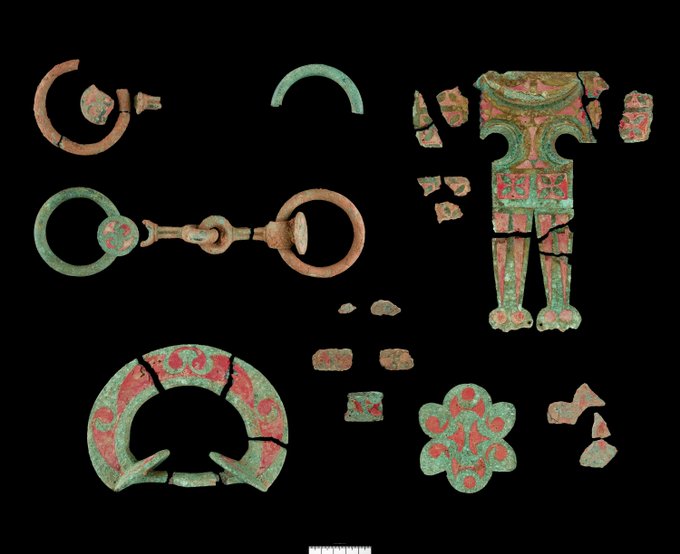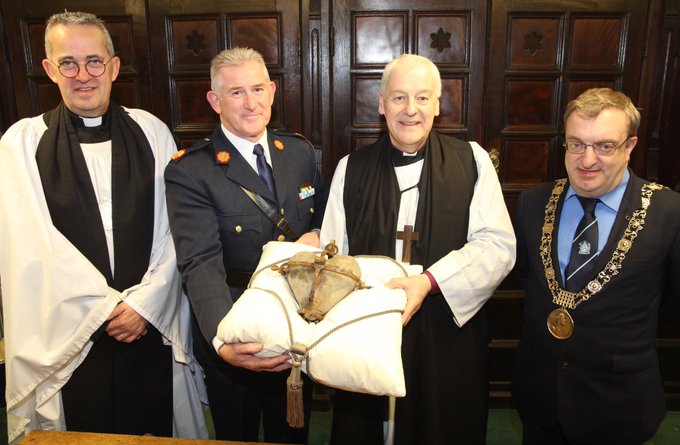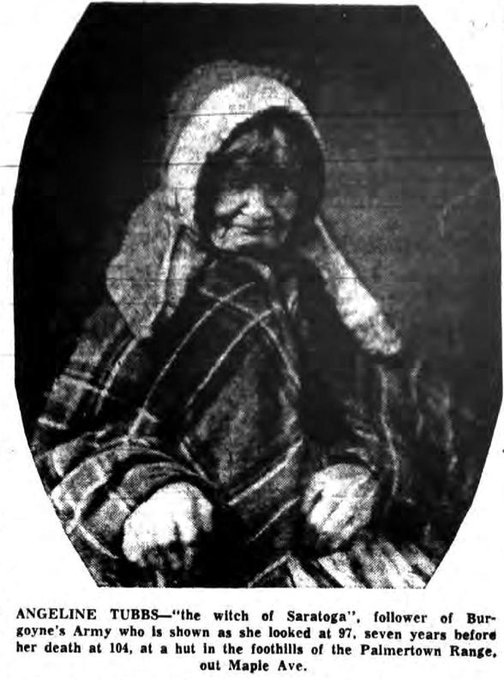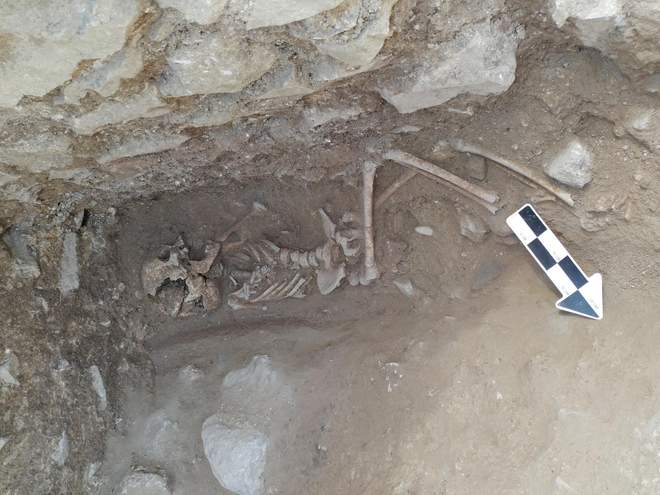Archeological discoveries are made all over the world every year, and some are strange enough to make your jaw drop. From the weird and wonderful to the totally terrifying, let’s investigate some of the most truly bizarre archeological discoveries.
Man Finds Old Buried Chain on Farm, Pulls Up Something Incredible
Everyone has their own hobbies and treasure hunting is what really gets some people going. Mike Smith is one of those guys. Like most amateurs, he’d found only a few old coins and various other trinkets over the years, and none were particularly valuable. But all that was about to change when he spotted something that would lead to the discovery of a lifetime.
Mike Smith has been
metal-detecting since he was just 12-years-old after receiving his first metal detector as a gift from his dad on Christmas day, 1977. He grew up in South Pembrokeshire in Wales, and spent many days exploring the vast countryside in search of something truly special. As he reached adulthood, he realized that he probably wouldn’t be able to make a steady living from his hobby. But his enthusiasm and love of the great outdoors continued to fuel his passion on as he secretly held onto hope that, someday, he might still find something big.After years of searching with little pay-offs, now-45-year-old Mike wasn’t expecting anything out of the ordinary when he decided to take his metal detector out for a spin on one rainy afternoon in February 2018. That day, the bad weather forced him to veer from his original course and into an area of unexplored farmland. While making his way across the moist turf, Mike heard the familiar beep of his metal detector and knew he must be onto something. Feeling the familiar sense of excitement building inside him, he decided to make a few more wide circles around the area.

As you probably know, metal detectors usually sound fainter the further away you get from a potential find. But as Mike moved away from the place where he heard the initial beep, something strange happened. He heard it beep again, but even louder this time! After checking that his metal detector was definitely in working order, Mike knew that there was only one way to find out if he was really receiving an accurate reading: he had to dig.After choosing a spot where his metal detector was beeping the loudest, Mike grabbed his shovel and started digging through the damp soil. After just a few minutes of digging, he had already created a hole about a foot wide and two foot deep when he started to feel something small and metal inside.
He carefully removed it from the hole, and initially thought it might be a rusted old coin or some sort of Medieval broach. But after removing some of the dirt using his hands, he noticed that the object had a greenish-hue and was decorated with some delicate and intriguing red engravings.

While he pondered the object as he turned it over in his hands, he noticed something else gleaming in the dirt. Unlike the first metal piece, this object seemed to be a little more stuck. Being cautious not to damage his new find, Mike threw down the shovel, got down on his knees and started to dig with his hands. Eventually, he realized that the object seemed to be a large, metal link of some kind. Stranger still, it was connected to something else directly beneath another, identical link. In fact, as he dug deeper still, he realized that this bizarre discovery seemed to be a large, rusted chain! But what was it connected to?As Mike cleared more of the surrounding earth, still no amount of pulling, prodding, or digging could dislodge the chain. Suddenly, he looked around and realized that the sun was already starting to set. So, he packed up his tools and vowed to come back first thing the next morning. All night, thoughts raced through his mind. He had read about the ancient burial chambers hidden beneath Pembrokeshire soil and couldn’t help but wonder whether he had stumbled across something sinister. At first light, Mike returned to find the site just as he’d left it. He began digging around the area where he had found the chain links and it wasn’t long until unearthed a few more unique metal pieces, including something that looked like part of a large ring. Perhaps it had once been attached to the top of the chain? After cleaning the dirt from the object, Mike noticed that it bore similar markings to the first object he’d found.

Being a history lover, he knew that the artefacts must be significant, so he decided it was time to tell someone about the discovery. So, he got in touch with the Portable Antiquities Scheme in Wales, and the anonymous field was soon sealed off for a trial excavation with the help of proper tools and techniques. Trained archaeologists from the National Museum Wales and Dyfed Archaeological Trust were then enlisted to help Mike with a larger dig that June, four months after his initial find. With proceedings underway, it soon became clear that Mike had stumbled on the pieces of a much bigger puzzle. In fact, the team were soon able to unearth a haul of at least nine artefact fragments during their exploration. The pieces varied greatly in shape and size, each with its own unique decorative markings and engravings. The rusted chain Mike had struggled to unearth was in fact a portion of something much larger. After being successfully removed, it seemed like it may have been severed from something, but could that something still be in the ground? The archaeologists had recovered an exciting treasure trove of artefacts. All they had to do now was find out what it all meant. By combining their expert knowledge, while drawing comparisons to the shape and decoration of other artifacts across Britain, the archaeologists concluded that the objects were likely made around 25-75 AD during the late Iron Age, that’s over 2,000 years ago!
As the name suggests, this period was particularly significant due to the introduction of iron working technology, which would have been used to create these intriguing artefacts. Historians were also able to determine that a number of the pieces are also elaborately decorated with late
Celtic art designs, also known as late La Tѐne art. To make these markings, red glass would be made and allowed to cool into shaped recesses in the bronze surfaces to create distinctive and vibrant flowing designs, while enamel was used to give the pieces a greenish hue. According to experts, this is the very first time that a group of artefacts with Celtic art decorations has ever been discovered in Pembrokeshire, but what are they?The collection are actually pieces of a Celtic chariot burial, as Mike had once suspected! The Celts were an early Indo-European people who spread over much of Europe from the 2nd millennium BCE to the 1st century BCE. Celtic Chariots, which were used as war and ceremonial vehicles, were used to display the power and identity of their owners and tribal communities in Iron Age vehicles.

The first object Mike had unearthed is actually part of the bridal harness, while the ring-like object is a large terret ring or ‘rein-guide’. This would have been attached to the harness, guiding the lines that run through the hands of the driver, through the terrets and to the horse’s bit to keep it from veering off track. Further discoveries also included parts of a large horse-brooch, a harness fitting and fragments of the bridle bit, which would have been connected to the chain links! These important pieces would once have been fixings to a complete chariot and the accompanying leather harness for its highly-trained pony-pair.

These chariot pieces may even have been witness to some of the key historical events of the time, when Iron Age peoples defended their ways of life from the expansion of the Roman empire, which came to include England and Wales from around 43AD.Following the initial investigation in June 2018, a further dig, funded by National Museum Wales, was carried out in March and April 2019. During these excavations, the archaeologists theories were confirmed when the tops of a pair of chariot wheels were revealed, proving that Mike’s discovery was just the start of a Celtic treasure trove! The two iron tires found would have covered the chariot’s wooden wheels, representing the first evidence of the chariot itself. The chariot artefacts probably belonged to a man or woman of some standing within their tribe or community. This speculation was supported by the discovery of an iron sword nearby, which may have been placed on or near the human burial that would have accompanied the chariot. In fact, it was customary for high ranking chiefs in the Iron Age would be laid to rest with their chariot, horses, tack and weapons.For his hard work and intuition, Mike Smith can now expect a hefty reward for what he claims is “the biggest ever metal detecting find”. In fact, an inquest in Milford Haven, Mike’s hometown, heard in January 2019 that the amateur metal detectorist could pocket up to a whopping sum of $1.3million after the historic discovery was officially declared as treasure! According to law, the payment must be shared fifty-fifty with the landowner, while Mike is also required to sell the grand total of 34 artefacts to a museum. Of course, The National Museum Wales is first in line, and hopes to purchase the finds so they can be properly conserved. For now, the exact location of the find is being kept a secret for a major dig in the future.
Ground-penetrating radar has already revealed a pattern of buried ditches and walls on the farmland, suggesting that Mike may even have stumbled upon an entire Celtic settlement that had gone undiscovered for thousands of years! Of course, Mike will still have also claim in any future finds at the site, and he can hardly believe his childhood dreams came true in the most unexpected way.
Iron Age Celtic Woman Found Buried In A Tree
In March 2017, a team of archaeologists in Switzerland made a harrowing discovery in the most unexpected of places. While renovating the Kern school complex in Aussersihl, a district in Zürich, they inadvertently disturbed the final resting place of an ancient corpse hidden in plain sight, inside a tree trunk!
The bizarre coffin had been fashioned out of a hollowed-out tree which still had bark on the outside. After the preserved remains were carefully removed from the site and sent for analysis, researchers concluded that it once belonged to an Iron Age Celtic woman who lived around 2,200 years ago! Though people often think the Celts hailed from the U.K., they actually lived in continental Europe as far East as modern-day Turkey! But how did this woman end her days in such seemingly unfortunate circumstances? Surprisingly, it was actually a common practice for Iron Age Celts across central and northern Europe to bury members of their tribe in “tree coffins”. The deceased would be decorated with jewelry and gifts and then buried underground in the hollowed-out tree, not unlike a modern-day coffin.
Isotope analysis of the woman’s bones revealed that she was a local woman who was around 40-years-old when she died and probably grew up in Limmat Valley. She rarely performed physical labor, and instead spent her time indulging in a diet of starchy and sweetened foods, sounds like luxury!
She had been richly attired in sheep’s wool, a sheepskin coat and shawl and was buried with accessories including an amber and glass necklace, bronze bracelets, and a delicate bronze belt chain decorated with pendants. This suggests she probably commanded great respect in her tribe. The remains were also found about 260feet from the grave of another Celtic man discovered in 1903 when the school’s gym was being built. He had been similarly adorned and buried with a sword, shield and lance. Because the two individuals were buried in the same decade around 200 B.C, it’s even possible that they knew each other!
The Lloyds Bank Coprolite
Let me start by staying that this bizarre object in the image below is so well-preserved that it was once referred to as being "as precious as the crown jewels". Any guesses? This is, actually, exactly what it looks like: a giant fossilized poop. But not just any fossilized poop, poop dating back to the ninth century, when what’s now York in England was ruled by Norse warrior-Vikings!
This coprolite, which is the official name for fossilized feces, was discovered in 1972 in York under what was to become a local bank. Hence the name the Lloyds Bank coprolite. Paleoscatologists, that’s the name for archaeologists who specialize in poop, determined that the proud and long-dead owner of this seven-inch excrement had a hearty diet of meat and bread. Unfortunately, though, they also had some nasty intestinal issues. Upon closer examination, experts found that the scat contained Whipworm and Maw-worm eggs, both of which would have caused stomach aches and other gastrointestinal symptoms! Today, you can find the coprolite on display inside a glass box at the museum section of York’s Jorvik Viking Centre. In 2003, one visitor group found themselves in a spot of doo-doo dropped the specimen and broke it into three pieces! Thankfully, it has since been repaired.
1700-Year-Old Roman Chicken Egg
During a dig that took place in the town of Aylesbury in Buckinghamshire, England between 2007-2016, archaeologists made an interesting discovery in a waterlogged pit, a basket of four chicken’s eggs! But these weren’t the kind of eggs you could pick up at the local supermarket. We’re talking 1,700-year-old Roman eggs!
As the team attempted to recover the eggs from the pit, though, something tragic happened. Three of the four eggs accidentally cracked, releasing what was described as an overpowering “potent stench”. Thankfully, the team managed to
preserve the fourth fragile egg, making it the only complete Roman chicken’s egg found in Britain! Chicken bones and broken eggshells had been found in Roman graves in Britain before, but never a complete egg. The lucky find was only made possible by the environment it was found in. In a pit that has been waterlogged for thousands of years, things are able to survive that never would have done so in a dry environment. Experts from Oxford Archaeology think the pit was used to brew beer during the second and third centuries AD, before being turned into some sort of Roman wishing well toward the end of the third century. The eggs, which were found alongside a breadbasket, leather shoes and assorted wooden vessels and tools, may have been a food offering tossed into the well in the hopes of winning the gods favor!
The Stolen Heart Of Saint Laurence O'Toole
This next story is about to bring a whole new meaning to the phrase “stealing hearts”! Back in 2012, an enterprising thief made off with a rather bizarre bounty from Dublin’s Christ Church Cathedral, the preserved heart of a 12th century patron saint!
The heart of St. Laurence O’Toole had been sealed inside a heart-shaped wooden box surrounded by an iron cage and had been displayed on the cathedral wall ever since the Medieval period! This might seem like a rather gruesome form of interior decoration, but saintly remains are actually a common feature of many Irish churches. St Laurence O’Toole died in Normandy, France in 1180 and was canonized in 1225 because of miracles said to have happened at his tomb.
But sometime between the night of Friday 2nd and the morning Saturday 3rd January 2012, someone broke into the cathedral and swiped the treasured relic. Church officials speculated that the thief could have hidden in the building overnight, and probably used metal cutters to prise open the iron bars protecting the heart.
The theft was particularly strange because the heart itself holds no economic value, while the valuable gold chalices and gold candlesticks in the Cathedral were ignored. Stranger still, the perpetrator lit two peace candles on the Trinity altar before leaving the building. Just when church officials had gotten over the initial heartbreak, another surprising discovery was made in April 2018. Following an “intelligence-led investigation”, Irish police came across the saintly heart in Dublin’s Phoenix Park, six years after it was stolen from the cathedral! Sadly, no arrests were made after fingerprint and forensic tests were conducted on the artefact, but the heart was returned to its rightful owner in Ireland once more. We’ll probably never know what this 800-year-old heart got up to over those 6 years, but it might have been on a magical sight-seeing tour!
Old Anti-Witchcraft Potion Found At Pub
It’s not unusual for discoveries to be made during the renovation of buildings that date back centuries, but one pub owner from Northamptonshire in England, got the shock of their life in October 2019 in the form of one rather spooky discovery.
Contractors were in the process demolishing the chimney at the pub, formerly known as the Star and Garter Inn, when they found something strange, lodged inside. It was a small, torpedo-shaped glass bottle, but it contained a bizarre haul of smaller items including fishhooks, human teeth, glass and an unidentified liquid which may or may not have been urine! While it seems like some kind of black magic, this eerie bottle of trinkets is actually a 19th century anti-witchcraft potion!

Glass torpedo bottles began to be made from around 1830 and usually held carbonated drinks, but occasionally they had a very different use. According to witch bottle researchers at the Museum of London Archaeology, these glass or stone vessels were believed to have been used as objects for protection or as the containers for a cure against witchcraft. More than 100 specimens have already been unearthed beneath the floors of historic buildings, on archaeological sites, in churchyards or riverbanks. But what was one doing inside the chimney of a small English pub? It turns out a famous witch called Angeline Tubbs, also known as the Witch of Saratoga, was actually born at the inn in around 1761! To this day, Tubbs is still the subject of ghost tours at Saratoga Springs in New York, where she moved aged 15 to tell fortunes. Considering the pub is so clearly steeped in a rich, witchy history it’s no surprise that a token used to ward off evil was found there. At least the witches of England now know they’re not going to get served at this pub!
The Vampire Child of Lugnano
These days, it’s a widely-accepted fact that Vampires are the stuff of nightmares and teen romance novels. But throughout history, belief in these fanged fiends was very real, and nothing proves that better than one bizarre discovery made in 2018. A team consisting of archaeologists from the University of Arizona and Stanford University were conducting a dig at an ancient Roman burial site in Italy when they stumbled upon some particularly odd-looking remains.
On first glance, this probably looks like any old skeleton, but if you look a little closer there appears to be a large stone wedged inside the jaw. The find was unearthed in Lugnano, Teverina at La Necropoli dei Bambini, a burial site which dates back to a malaria outbreak in 400AD and contains many young remains. By examining dental development, anthropologists were able to determine that the specimen likely belonged to a 10-year-old child. The discovery left the team scratching their heads, both because the remains belonged to someone far older than more than 50 other burials found at the site, and, of course, because of the purposeful nature of the whole “stone in the mouth” thing. But what does it mean? Previous excavations have also revealed objects associated with witchcraft and magic, including raven talons, toad bones, bronze cauldrons filled with ash and the remains of animal sacrifices. According to historians, the Romans were very concerned with supernatural paranoia, and would even go to the extent of employing witchcraft to keep the evil contaminating the body from coming out.
So, the stone is most likely part of a ritual "vampire burial" used to prevent the child, who may have been considered evil, from rising from the grave. The discovery, which is now being referred to locally as ‘
the vampire child of Lugnano’, was described by Archeologist and professor David Soren, who has been excavating the site since 1987, as “extremely eerie and weird”. If you were amazed at these bizarre archeological discoveries, you might want to read about
incredible discoveries found underground. Thanks for reading!































